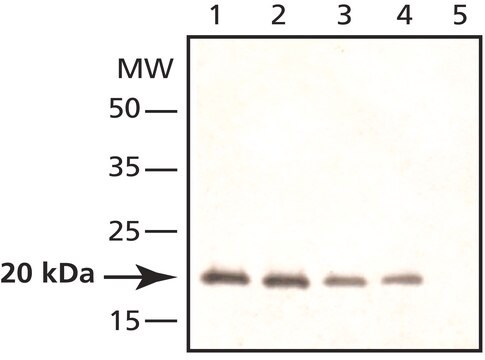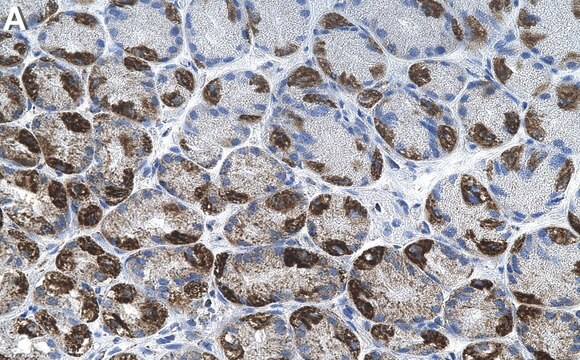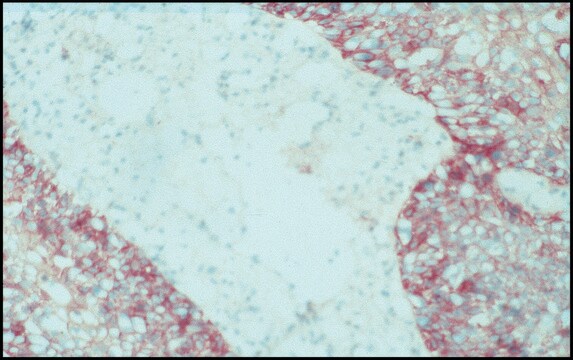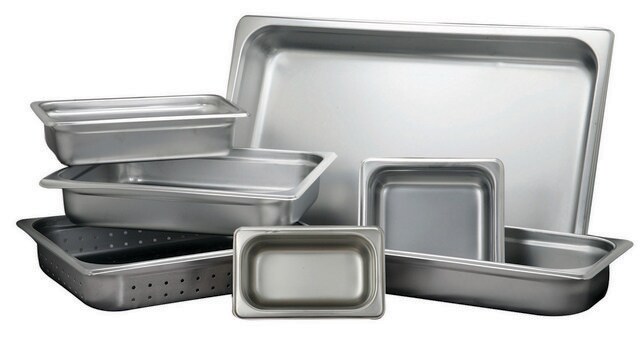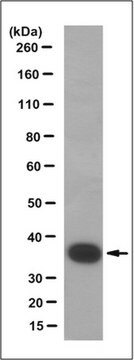Allgemeine Beschreibung
We are committed to bringing you greener alternative products, which adhere to one or more of The 12 Principles of Green Chemistry. This antibody is Preservative-free, produced without the harm or sacrifice of animals and exceptionally stable to allow for ambient shipping and storage if needed and thus aligns with "Waste Prevention", "Designing Safer Chemicals" and "Design for Energy Efficiency".
Click here for more information.
ZooMAb® antibodies represent an entirely new generation of recombinant monoclonal antibodies. Each ZooMAb® antibody is manufactured using our proprietary recombinant expression system, purified to homogeneity, and precisely dispensed to produce robust and highly reproducible lot-to-lot consistency. Only top-performing clones are released for use by researchers. Each antibody is validated for high specificity and affinity across multiple applications, including its most commonly used application. ZooMAb® antibodies are reliably available and ready to ship when you need them.
Spezifität
Clone 1K15 is a ZooMAb® rabbit recombinant monoclonal antibody that specifically detects Caveolin-2. It targets an epitope within 17 amino acids from the N-terminal region.
Immunogen
KLH-conjugated linear peptide corresponding to 17 amino acids from the N-terminal region of human Caveolin-2.
Anwendung
Quality Control Testing
Evaluated by Western Blotting in Human umbilical vein endothelial cell (HUVEC) lysate.
Western Blotting Analysis: A 1:1,000 dilution of this antibody detected Caveolin-2 in Human umbilical vein endothelial cell (HUVEC) lysate.
Tested Applications
Western Blotting Analysis: A 1:1,000 dilution from a representative lot detected Caveolin-2 in Human kidney tissue lysate.
Immunohistochemistry (Paraffin) Analysis: A 1:1,000 dilution from a representative lot detected Caveolin-2 in human kidney tissue sections.
Immunocytochemistry Analysis: A 1:100 dilution from a representative lot detected Caveolin-2 in Human umbilical vein endothelial cells (HUVEC).
Note: Actual optimal working dilutions must be determined by end user as specimens, and experimental conditions may vary with the end user.
Zielbeschreibung
Caveolin-2 (UniProt: P51636; also known as CAV2) is encoded by the CAV2 gene (Gene ID: 858) in human. Caveolins are oligomeric integral membrane proteins that are widely used as markers of caveolae. Three gene encode for caveolins in mammalian cells: caveolin-1 (CAV1), caveolin-2 (CAV2) and caveolin-3 (CAV3). CAV1 and CAV3 are shown to be essential for caveolar formation in non-muscle tissues and striated muscle, respectively. CAV2 plays a facilitatory role in combination with CAV1. It is a major protein component of cholesterol- and glycosphingolipid-rich flask-shaped invaginations of plasma membrane caveolae. It plays an important, and often more direct, role than CAV1 in regulating signaling and function in a cell- and tissue type-specific manner. CAV2 tightly interacts with CAV1 and forms hetero-oligomeric complexes within caveolae. This interaction is essential for transport of CAV2 to the cell surface. In the absence of CAV1, CAV2 is degraded, and its expression is significantly reduced. In addition to the plasma membrane, it can also exist in other subcellular compartments such as the endoplasmic reticulum, Golgi, cytosolic vesicles, lipid droplets, and the nucleus. CAV2 interacts directly with G-protein alpha subunits and can functionally regulate their activity. It is also required for the insulin-stimulated nuclear translocation and activation of MAPK1 and STAT3, and the subsequent regulation of cell cycle progression. CAV2 undergoes phosphorylation on serine 23 and 36 and the phosphorylated form plays a role in modulating mitosis in endothelial cells. Serine 23 phosphorylation is considered as a specific marker of CAV2 targeting to plasma membrane caveolae and lipid rafts in epithelial and endothelial cells. On the other hand, serine 36 phosphorylated CAV2 primarily resides in intracellular perinuclear region. CAV2 also undergoes Src-induced phosphorylation on tyrosine 1 and this form is localized mainly near focal adhesion sites. This ZooMAb® recombinant monoclonal antibody, generated by our propriety technology, offers significantly enhanced specificity, affinity, reproducibility, and stability over conventional monoclonals. (Ref.: Sowa, G. (2011). Biochem. Res. Int. 2011; 809259; Sowa, G., et al. (2008). 47(1); 101-111).
Physikalische Form
Purified recombinant rabbit monoclonal antibody IgG, lyophilized in PBS, 5% Trehalose, normal appearance a coarse or translucent resin. The PBS/trehalose components in the ZooMAb formulation can have the appearance of a semi-solid (bead like gel) after lyophilization. This is a normal phenomenon. Please follow the recommended reconstitution procedure in the data sheet to dissolve the semi-solid, bead-like, gel-appearing material. The resulting antibody solution is completely stable and functional as proven by full functional testing. Contains no biocide or preservatives, such as azide, or any animal by-products. Larger pack sizes provided as multiples of 25 µL.
Rekonstituierung
0.3 mg/mL after reconstitution at 25 µL per vial. Please refer to guidance on suggested starting dilutions and/or titers per application and sample type.
Lagerung und Haltbarkeit
Recommend storage of lyophilized product at 2-8°C; Before reconstitution, micro-centrifuge vials briefly to spin down material to bottom of the vial; Reconstitute each vial by adding 25 µL of filtered lab grade water or PBS; Reconstituted antibodies can be stored at 2-8°C, or -20°C for long term storage. Avoid repeated freeze-thaws.
Sonstige Hinweise
Concentration: Please refer to the Certificate of Analysis for the lot-specific concentration.
Rechtliche Hinweise
ZooMAb is a registered trademark of Merck KGaA, Darmstadt, Germany
Haftungsausschluss
Unless otherwise stated in our catalog or other company documentation accompanying the product(s), our products are intended for research use only and are not to be used for any other purpose, which includes but is not limited to, unauthorized commercial uses, in vitro diagnostic uses, ex vivo or in vivo therapeutic uses or any type of consumption or application to humans or animals.


